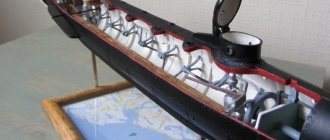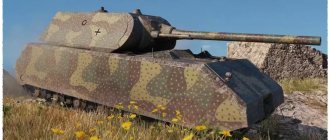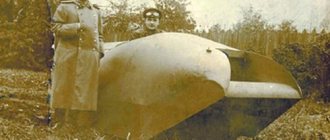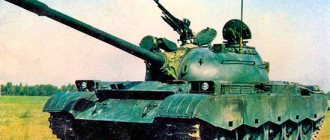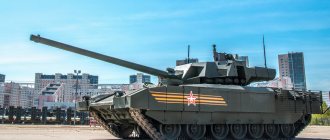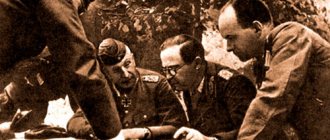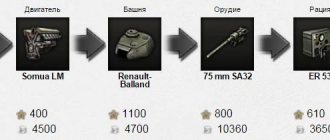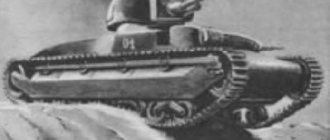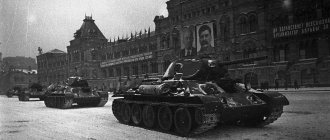At the Victory Parade, the Russian army demonstrated the newest T-14 Armata tank. This ultra-modern combat complex in many respects has no equal in the world. Does this mean that the tank is also the most expensive?
Modern war is significantly different from the one we are used to seeing in old films. And the same T-14 tanks that walked along Red Square side by side with the famous T-34s only superficially resemble their predecessors.
A unique tank of our time can fire not only shells, but also guided missiles. The armor has become active, and the vehicle is able to protect itself by shooting down targets on approach. Modern radars became the “eyes” of the T-14, and some of the technologies were borrowed from the aviation industry.
Finally, the tank's turret and turret are controlled remotely. Experts call the Armata a step towards promising robotic combat vehicles.
And Uralvagonzavod was able to put all these miracles into an unpretentious and by no means fragile shell, which is not afraid of even the highest and lowest temperatures. Theoretically, combat operations could even take place in the Arctic!
Against this background, you think about how much such a tank could cost and what the production volume would be. Let us immediately note that at the moment the cost of the T-14 is higher than that of its predecessor the T-90. But the Ministry of Defense is ready to purchase 3.2 thousand of the latest vehicles. How much money will have to be spent and how much will Russia’s geopolitical allies and opponents spend on their main tanks?
ZTZ-99 (PRC) - $2.6 million
A representative of the third generation of Chinese tanks, developed as an alternative to the Soviet T-72 after the deterioration of relations between the two countries, but which entered service only in 2001.
As of 2011, according to various sources, the Chinese People's Army has 600-800 such vehicles in service. For tank building in the Celestial Empire, the ZTZ-99 is a real breakthrough, and its low cost allows for rapid mass production.
Nevertheless, modern technologies are used here. First of all, this is a laser warning system for incoming enemy missiles, which can simultaneously be used to blind an enemy using optical guidance systems. The armor has been upgraded to resist cumulative projectiles.
"Echo of War"
Now there are many advertisements on the Internet about the sale of a tank. And it's not a joke. The fact is that in almost all countries it is possible to buy a tank absolutely legally. The price depends on the model and starts from about 2 million rubles. Naturally, this will not be a combat vehicle, but a so-called demilitarized one, which does not have the ability to shoot, and all additional on-board weapons have been removed. According to the documents, the vehicle will be used as a tracked tractor or tractor. But driving around the city to work or to the store will not work - such equipment is prohibited from moving on asphalt. She can only maneuver on country roads.
The greatest demand is for T-34s, of which there are quite a few left after the war. German models are in second place, but they are more difficult to find, and the prices are quite exorbitant. But it is also possible to purchase more modern models, for example, the T-72 for 1.7 million rubles. So, we figured out how much a tank costs. But it is better not to have anything to do with such technology.
Arjun Mk II (India) – $6.0 million
India is independently developing tanks and is quite satisfied with the results of its work. The Arjun Mk II combines the best solutions used to create both Soviet and Western vehicles.
A standard Western 120 mm caliber gun with a rifled barrel, composite armor, laser target detection systems, and even special smoke grenades that knock enemy missiles off course—the modern Indian tank has all this.
Merkava Mark IV (Israel) - $6 million
Israel has 300 Merkava Mark IVs at its disposal and has an order for another 300 of these vehicles. The tanks have long earned the title of the best in the region and are created specifically for combat operations in desert and hot areas.
Given the specifics of Israeli military operations, for the Mark IV, defensive systems are almost more important than offensive ones. The enemy does not have much heavy equipment, but you have to defend against surprise attacks using missiles and mines.
As a result, the most modern Merkava has armor using metal combined with ceramics. At the moment, active armor is being developed, which resembles the protection of the T-14 “Armata” based on the principle of operation.
Leopard 2A6 (Germany) - $6.79 million
The first versions of Leopard 2 entered service with German troops back in the late 70s. Since then, the highly proven machine has been exported to Canada, Finland, Greece and Portugal. The German tank platform is so successful that they prefer to modernize it rather than change it.
Modern versions feature sophisticated armor that uses tungsten. Ammunition is stored in an isolated compartment, which helps protect the crew from incidents. O were used by Canada during military operations in Afghanistan.
T-14 (Russia) - $7.8 million
The estimated cost of the T-14 tank on the Armata platform is at least 400 million rubles. It is known that the Ministry of Defense is considering options to reduce the price tag, but do not consider the current price fabulous.
In our ranking, the first representative of a new generation of tanks with an uninhabited turret occupies only 6th place. Its less advanced and older competitors cost more. The T-14 combines all the cutting-edge technologies in the offensive and defensive fields.
However, some parameters, such as the caliber of the gun, are left unchanged so that the vehicle can use standard ammunition. Active protection "Afganit" has been installed. It is capable of intercepting not only cumulative grenades and anti-tank guided missiles, but also sub-caliber projectiles on approach to a tank.
The crew is reliably protected from explosions, as it is located in an isolated armored capsule, just like the ammunition. The automatic anti-aircraft gun, like other means of firing, is controlled remotely.
Characteristics
| Table of performance characteristics of the main serial modifications of the T-80 tank | ||||
| Modification | T-80 | T-80B (T-80BV) | T-80U | T-80UD |
| History of creation | ||||
| Developer | LKZ | LKZ | LKZ | HZTM |
| Year of adoption | 1976 | 1978 (1985) | 1985 | 1987 |
| Dimensional and mass characteristics | ||||
| Combat weight, t | 42 | 42,5 (43,7) | 46 | 46 |
| Length with gun forward, mm | 9656 | 9651 | 9556 | 9664 |
| Case length, mm | 6780 | 6982 | 7012 | 7020 |
| Width, mm | 3525 | 3582 | 3603 | 3755 |
| Tower roof height, mm | 2300 | 2219 | 2215 | 2215 |
| Ground clearance, mm | 451 | 451 | 451 | 529 |
| Protection | ||||
| Dynamic protection | No | no (“Contact-1”) | "Contact-5" | "Contact-5" |
| Active protection | No | No | No | "Curtain" |
| Armament | ||||
| Brand of gun | 2A46-1 | 2A46-2 / 2A46M-1 | 2A46M-1 / 2A46M-4 | 2A46M-1 |
| Gun ammunition, rds. | 40 | 38 | 45 | 45 |
| Guided weapons | No | 9K112-1 “Cobra” / 9K119 “Reflex” | 9K119 "Reflex" /9K119M "Reflex-M" | 9K119 "Reflex" |
| Mobility | ||||
| Engine make | GTD-1000T | GTD-1000TF | GTD-1000TF / GTD-1250 | 6TD |
| engine's type | gas turbine | gas turbine | gas turbine | diesel |
| Engine power, hp | 1000 | 1100 | 1100/1250 | 1000 |
| Maximum speed on the highway, km/h | 70 | 70 | 70 | 60 |
| Cruising range on the highway, km | 500 | 500 | 450 | 560 |
| Specific power, hp/t | 23,8 | 25,8 (25,17) | 21,74/27,2 | 21,7 |
| Specific ground pressure, kg/cm² | 0,83 | 0,865 | 0,93 | 0,924 |
M1A2 SEP (USA) - $8.5 million
There is some irony in this: the American main tank of the first generation is more expensive than the most modern Russian one. At the same time, it must be taken into account that the Abrams has been modernized more than once and currently meets all the requirements of modern warfare.
The shortcomings during military conflicts in the Middle East have been eliminated. The newest version of the tank weighs as much as 69 tons, and the reason is the complex armor, which uses very heavy depleted uranium. In the urban combat version, the Abrams is also equipped with a remote-controlled machine gun.
"Armata"
The new Russian tank was presented to the general public on May 9, 2015 during a parade on Red Square. Long before him, everyone was wondering: how much does a tank cost? Naturally, no one could give an exact figure. But considering that this is a latest-generation model, an order of magnitude superior to others, we can conclude that the amount must be considerable.
In 2014, figures of 400 million rubles per unit surfaced, but at the beginning of 2015, the director of the plant where the Armatas are manufactured said that their cost would not exceed 250 million rubles. And this is already more like the truth.
Challenger 2 (UK) - $8.6 million
The British tank resembles the American one in “philosophy”. It also weighs 69 tons due to its massive composite armor, the composition of which is classified. As a result, a 1200-horsepower engine, quite weak by industry standards, has difficulty coping with its responsibilities.
But for the conflicts in Yugoslavia and Iraq, where American and British vehicles were shot at with anti-tank systems, armor, as it turned out, is hardly the main guarantee of victory. At the same time, the UK’s exports somehow didn’t work out: only Oman agreed to purchase the Challengers.
K2 Black Panther (Republic of Korea) – $8.8 million
South Korea's main geopolitical adversary is its northern neighbor. And this neighbor has a huge arsenal of Soviet military equipment, in particular tanks. For this reason, the Republic of Korea is ready to spend a lot of money on developing combat systems capable of repelling Kim Jong-un’s troops.
“Black Panther” can do much of what “Armata” can do. It also has an automatically loading main gun, “smart” reactive armor, and a wide range of means to counter enemy missiles and shells. However, the active protection system is still only at the development stage, like the Merkava.
Type 10 (Japan) - $9.4 million
It would seem, why does Japan need tanks? The Japanese will not agree with this opinion, because in Southeast Asia the Land of the Rising Sun has many potential opponents who have the most modern offensive weapons.
The Type 10 is one of the newest tanks on our list. It entered service with the troops in 2012. The Japanese are relying on the maneuverability of the vehicle, which weighs “only” 48 tons. The 120 mm smoothbore gun can use both locally developed shells and those supplied to NATO members.
Combat use
T-80U at the tank biathlon, 2013
- White House shooting in 1993. On October 4, 1993, six T-80UD tanks of the 12th Guards Tank Regiment of the 4th Guards Kantemirovskaya Tank Division from the Kalinin Bridge at about 12 noon opened fire on the building of the Supreme Council of the Russian Federation. A total of 12 shells were fired, including 2 armor-piercing sub-caliber and 10 high-explosive fragmentation shells.
- First Chechen war (1994-1996). They were also used during the assault on Grozny and suffered losses. They were not used during the second Chechen war.
- In January 2015, T-80BV tanks were used during the armed conflict between Shiite rebels and government forces in Yemen. At the same time, at least one tank was destroyed and another was captured by the rebels.
- In January 2015, the OSCE Mission repeatedly recorded T-80 tanks without identification marks in the armed conflict zone in eastern Ukraine, moving through territory controlled by the self-proclaimed DPR and LPR.
AMX-56 Leclerc (France) – $10 million
The main tank of France in its most modern version has been produced since the early 90s. Before this, engineers spent about 15 years fine-tuning the then-state-of-the-art offensive and defensive systems. The modular armor mesh allows you to quickly replace damaged areas.
The armor also uses Kevlar in combination with metal and ceramics. After scandals surrounding Leclerc's purchase prices and the implementation of the procurement plan, production was stopped. After the devaluation of the euro, the cost of the tank in dollars decreased, but it still costs about $10 million.
In real combat conditions, the most expensive tank was practically not used and was only deployed in certain Middle Eastern countries as part of peacekeeping missions.
Source:
Constant and inexorable growth: the problem of tank costs
The T-90S is not the most expensive, but the most successful MBT on the modern market. Photo: Indian Ministry of Defense
The commercial success of a tank or other armored vehicle depends on several main factors. First of all, these are tactical and technical characteristics. Of great importance is the correspondence of the parameters and capabilities of the product to the current needs of the market and specific customers. In addition, cost remains the most important factor. A perfect and overly expensive combat vehicle will be able to attract attention - but this interest will not yield any commercial results.
Main trends
Tanks are necessary for any developed army, and therefore such equipment occupies a special place in the international arms market.
At the same time, the armored vehicles sector has interesting features related to the specifics of tank production or modernization, the needs of buyers, etc. First of all, it is necessary to remember that only a few countries currently have full-fledged tank production. Production lines operate in Russia, Germany, Israel, India, China, etc. These same countries, independently or with foreign assistance, are developing and implementing projects to modernize existing equipment.
One of the Ukrainian options for modernizing the T-64 with an eye to export. Photo "Ukroboronprom"
The USA, France, Italy, Ukraine and some other countries have the competence to build tanks, but do not currently use them. For now, they are limited only to the modernization of existing models, although the possibility of creating new projects is not excluded.
According to various estimates, the bulk of sales on the international market are made up of used tanks. Older types of armored vehicles may be sold in connection with the acquisition of modern equipment. In addition, some countries in the recent past had large reserves of tanks at their disposal, and decided to put them on sale.
Used tanks can be sold “as is” or repaired with the restoration of basic functions, depending on the wishes of the customer. It is also possible to upgrade before delivery with the replacement of equipment and the introduction of new functions. Such work is also quite a profitable business. Moreover, there is and is constantly expanding a whole category of modernization projects initially aimed at foreign orders.
Export T-90SM. Photo Vitalykuzmin.net
Thus, at present, any army can find a tank that best meets the requirements and corresponds to its financial capabilities. However, it is often the monetary factor that is decisive, which reduces sales of modern vehicles and stimulates the growth of the “secondary market” with used tanks and modernization projects.
With mileage around the tankodrome
Tanks of relatively old models, morally and physically obsolete, and having exhausted most of their service life, are not very expensive.
For example, deals in recent years for the sale of T-55 armored vehicles provided for a payment of approx. 150-200 thousand dollars per piece. Eastern European countries, former participants in the Warsaw Warfare Division, sold T-72 early modifications at approximately the same price. Rearmament often contributes to the fall in prices for newer MBTs, rendering them an almost useless asset. Repairs and modernization can improve the performance of a tank and extend its service life, as well as increase its cost. For example, in 2016, Russia received an order to modernize T-72B tanks under the B1 project with subsequent transfer to the Nicaraguan army. For 50 cars the customer paid approx. $80 million - average 1.6 million per unit.
Modernized T-72B3 mod. 2016. Photo Vitalykuzmin.net
Until recently, Ukraine was quite actively trading in repaired MBTs. After the collapse of the USSR, it actually got a large number of different tanks for free, and they were quickly introduced to the international market. For a restored and improved T-64, depending on the specifics of the upgrade, they asked for $1-1.2 million.
Modern modernization projects provide a significant increase in performance, but are expensive. Thus, in 2013 it was reported that the cost of upgrading the T-72B tank to the T-72B3 for the Russian army exceeds 50 million rubles. (approx. $2 million at the exchange rate of that time). About 60% of these expenses went to overhaul of the MBT, the rest - to new components. Subsequently, a new version of the “B3” project was created with a different set of equipment. According to various sources, the cost of such modernization reached the level of 75-80 million rubles.
A similar project to modernize old tanks according to a new project is now being implemented in the USA and is designated M1A2C or M1A2 SEP v.3. The first contract for such tanks was signed in 2022 and provided for the upgrade of 45 vehicles for $270 million. Thus, the average cost of modernization reached 6 million - not counting the costs of building the tank in the past.
American tank M1A2C, the latest version of the Abrams. US Army Photo
Poland recently announced its intention to purchase American tanks of the latest modification. For 250 M1A2C vehicles, spare parts, personnel training, etc. plan to spend approx. 6.04 billion dollars. Thus, the life cycle of each tank will cost 24 million dollars. Under the terms of the SEP v.3 program, only the modernization of existing MBTs with the previous update package is carried out. Accordingly, Polish plans approximately show the total cost of production of the tank itself, several of its upgrades, as well as the costs of operational operation.
Equipment from the factory
Due to obvious advantages, new-built tanks retain a significant market share.
Most agreements provide only for the sale of equipment, but in some cases licensed production is organized with the assembly of tanks at the customer’s enterprise. The Russian T-90S is deservedly considered the best-selling tank of our time, and its main buyer is India. Orders for the supply of finished vehicles had been received since the beginning of the 2000s, and then a Russian-Indian agreement appeared on the organization of assembly at the customer’s territory. According to it, in the coming years the Indian army was to receive 1000 new MBTs with a total cost of approx. $2.5 billion (about $3.4 billion taking into account inflation). Thus, one tank cost $2.5 million.
South Korean K2, one of the most expensive tanks in history. Photo: Wikimedia Commons
In 2014-15 licensed assembly was organized in Algeria. That contract provided for the production of 200 MBTs of the T-90CA type with a total cost of approx. $1 billion, i.e. 5 million each.
At the beginning of the tenth years, the T-90AM and T-90SM tanks, based on the serial T-90, were presented. Advertising materials and other communications included the cost of a new-build export "SM". Depending on the configuration, it could exceed $4 million.
The German Leopard 2A7+ tank, which is the latest modification of the family, demonstrates certain commercial successes. Thus, in 2013, a contract was signed for the supply of 62 similar vehicles and other equipment to the Qatari army. In 2018, an agreement was signed on the supply of 44 tanks and other vehicles to Hungary. In both cases, we were talking about new-built tanks costing approx. $10 million each.
German Leopard 2A7+, another contender for the cost record. Photo by KMW
Since 2014, South Korea has been transferring its tank forces to a modern MBT of its own design, the K2 Black Panther. At the start of production, the cost of such a vehicle was $8.5 million, which made it the most expensive tank in the world. At current prices, this is almost 10 million - and “Black Panther” retains the controversial leadership in terms of cost. Despite this, K2 is attracting the attention of potential foreign customers. Negotiations are currently underway with Poland and Norway.
Cost problem
When creating modern tanks, advanced and complex components and technologies are used.
Due to this, the required level of performance is achieved, but the complexity of production and the price of the finished machine increase. As a result, prices for armored vehicles are constantly and inexorably rising, causing concern to military departments. Even developed and rich countries are forced to reduce their plans, and other states are deprived of any chance of obtaining modern armored vehicles. It should be noted that in promising projects, customers impose fairly strict restrictions on the cost of the tank and its life cycle. However, the technical requirements for these programs set another increase in characteristics and introduce new functions. This should lead to another complication of the combat vehicle, and at the same time to an increase in price. Whether it will be possible to find a way out of this vicious circle is unknown.

